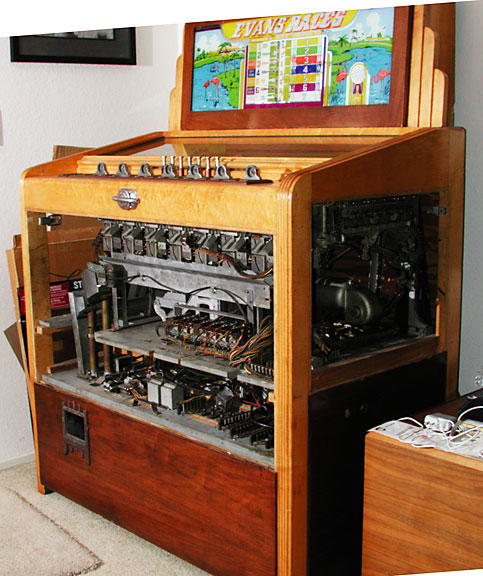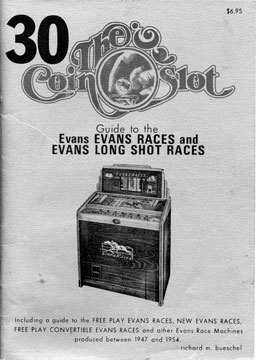Evans Races (1946-1954)
The following is information from the Coin Slot reprint of the Evans Races Maintenance Manual. It contains some advertising words and a short description of the history. Evans purchased the tooling from Pace and continued the development and manufacturing of the original Paces Races. See my other pages for a description of the differences and a list of some of the improvements Evans made.
Evans races is a gambling horse race game. Increasingly slot machines were being outlawed. Slot machines were considered pure gambling devices. So game manufacturers were inventing entertaining and different ways of allowing the player to gamble, while still managing to take their money. Evans is a gambling machine not much different from a slot machine.
Play consists of the customer inserting coins in any of the slots, with one slot for each horse. The player is gambling that the horse of his choice is going to come in first. The customer then presses a lever signifying he or she is finished betting and the race begins. The horses race to the finish line, controlled by the same mechanism often found in player pianos, a roll with punched holes. An odds wheel spins showing the payout for each horse. A payout is made if the chosen horse wins, and the amount is based on the odds for that particular horse.
This particular game has two modes of play. One mode is a pure gambling game, with the player inserting coins as bets, and the game paying the winnings at the end of each game in a hidden tray at the base of the console. The other mode is known as free play although there is nothing really free about it. The winnings are not paid but are accumulated in the machine and displayed with a magic eye, or projected onto the glass at the top of the game. The player can now use those accumulated winnings to make further bets by pressing buttons at the top of each coin slot. The proprietor of the establishment has a hidden switch that causes the game to switch modes. Imagine patrons gambling when suddenly the federal agents show up. The switch is thrown and now the game accumulates winnings and no illegal payouts are made. Once the agents leave, the switch is returned and now the game pays out the winnings.
One concern about the game driven by a piano roll is a worry about a player memorizing the pattern of wins. Clearly the game is deterministic and watching the game for long enough will divulge the series of winning horses. As Evans developed the game, more effort was put into trying to randomize the results. For example, there is a stop lever on a chain that drives the piano roll. The position of the stop lever relative to the winning horse increases the number of patterns but does not eliminate them.
I had an interesting conversation with the coin operated game historian Richard Bueschel about the Evans Races regarding the efforts to randomize the results. There is a small pinball machine in the bowels of Evans Races. When the leading horse reaches the three quarter mark on the track, the game energizes a solenoid that shoots a ball inside the enclosed pinball board. The ball bounces back down to the bottom and closes a switch. The game then senses which horse is in the lead and provides that horse with double increments instead of single. This randomizes the game because of the variable amount of time it takes the ball to bounce to the bottom and also adds excitement because the horse appears to race away to the finish.

A Triumph of Engineering
H. C. EVANS COMPANY
Again Proudly Presents an Outstanding Addition to its Line of Consoles in The New Evans Races, Outstanding in Beauty, Amusement, Earning Ability and Engineering
This console, which has been acclaimed as the greatest racing machine ever produced, has justly earned that reputation after being presented to the entire industry at both public and private showings.
There is no make-believe about this race. Seven horses actually racing, with speed, color and excitement, on a straight-away track in full view of all players. No other console or coin operated machine offers the players this thrill, fun and excitement.
There is a winner every race, with a Sweepstakes jack pol, amounting to $5.50 on a 5c machine, appearing at opportune moments to increase earnings and stimulate play. thereby assuring the operator greater profits and longer life on locations.
All operators are fully aware of the fact that H. C. Evans & Company purchased outright sometime ago from the Pace Manufacturing Company of Chicago all the patents. dies, patterns, etc., covering the original Paces Races. The new Evans Races includes many of the well known features of the original Paces Races, and in addition the noted improvements which have been made by H. C. Evans &- Company since taking over this machine.
The pneumatics on this machine have been reduced by 50°0 and the only ones now used operate the horses and reverse the paper roll, which fact will immediately lend itself to all operators from a service standpoint. Another outstanding feature is the installation on all Evans Races of the well known Musser Brake, which absolutely eliminates slipping or sliding of the horses. All patents, dies, etc. covering this brake have been purchased from the inventor and are now owned exclusively by the Evans Company.
The new Evans Races is built to the same precision engineering as are all H.C. Evans & Company products. and operates on 60 cycle, 110 volt A. C. Information for operation on any other current will be supplied upon request.
DIMENSIONS Height 59 inches Width 42 inches
Depth 30 Inches Weight .. 350 pounds
You Can Buy This Machine With Confidence and Operate It With Pleasure.

The Coin Slot Guide to the Evans EVANS RACES and EVANS LONG SHOT RACES
The maintenance and care of your Evans Race Machine
The thrill of the race, the horses hurtling across the track, the odds changing and that final surge across the finish line under your left hand. Finally, the chattering of payout coins. It all sounds very exciting, and most of it sounds like a Pace RACES RACES. But that's not the case this time. Sure, the machine in question started out as a PACES RACES (See Coin Slot Guides No.7 and No. 16) and then it took its own header. This is the EVANS RACES we're talking about, made by H. C. Evans and Company of Chicago between 1947 and 1954 when the firm went out of business. The buzz words are "horses hurtling across the track" and the finish of the race "under your left hand." On the PACES RACES and on its revamped BAKER'S PACERS the horses run away from the player and finish at the far end of the machine. Not so on EVANS RACES; they run from right to left in full presence of the player or players. That's only the beginning of the changes. When H. C. Evans finally got around to introducing their new console machine at the coin machine show at the beginning of 1947 they had a lot to talk about. They claimed that EVANS RACES was "the console that stole the show," to quote the February 15th issue of THE BILLBOARD. The old-fashioned player-piano pneumatics of the PACES RACES line became electro-pneumatic control on the Evans machine. That meant that play was three times as fast, and operator profits three times as much. Evans added their own "slug proof 7-coin head" and brightened up their EVANS RACES machine far in excess of any racing console that had yet been placed in the market. This machine and its various models are serviced by This Coin Slot Guide.
Fruit of the Family Tree
The first and foremost console race machine was the Pace PACES RACES of 1934-1941. In October 1944, at the height of World War 2, Pace sold out the rights and their remaining inventory in the game to H. C. Evans and Company, and threw in the dies and tooling. Evans immediately went into the production of replacement parts, and promised a "New Evans SUPER DELUXE RACES. Streamlined! New Coin Head! 50 other new features!" after the war was won.
It was logical that Evans would be the firm that would bring PACES RACES back to life in a new format after the war. They were already recognized as one of the largest and most successful I console producers in the coin machine business and had earned the respect of the industry with their electric spinner GALLOPING DOMINOS (See Coin Slot Guide No. 10) and three-reel console.
Bell LUCKY LUCRE (See Coin Slot Guide No. 26) machines. So VE-Day ("Victory in Europe") and VJ-Day ("Victory over Japan") came and went, and Evans came back in 1946 with postwar models of the GALLOPING DOMINOS, BANG TAILS and WINTER BOOK electric consoles (Coin Slot Guide No. 10) as well as the CASINO BELL Console Bell (Coin Slot Guide No. 26). But no race machine.
By the time the game made it to the market in 1947 its name had changed. Now it was EVANS RACES in cash payor free play models in 5c or 25c play. It was also far more elegant and complicated than any PACES RACES ever built. Success with the line led to an improved model in 1948 as the NEW EVANS RACES, backed by a convertible free play or cash pay F R E E P LAY CONVERTIBLE EVANS RACES and a High-payout EVANS LONG SHOT RACES. These are the models that remained in production off and on until 1954.
How to Use This Manual
It seems to have been a tradition at H. C. Evans And Company; while the machines were great the manuals were crummy. The first and only EVANS RACES manual carries a 1947 copyright and combines notoriously poor pictures with a few good line drawings interspersed with an endless array of type written part numbers.
Things didn't get much better when the newer NEW EVANS RACES and its follow-on models were introduced in 1948. Frankly, they got worse. Evans produced a colorful new sales brochure for the line, added some updated ditto machine operating instruction sheets headed "Evans Races" -but still hand typed as a master rather than typeset, mind you -- and stuck the new pieces inside of the 1947 manual and passed the whole makeshift package along with the new machines. The only advantage to this sorry situation is the fact that this material thereby serves and services all of the machines in the line.
This Coin Slot Guide has been reproduced from just such a package as delivered with a NEW EVANS RACES to a Chicagoland operator in 1949. The front cover shows the newer model pictured in the 1948 selling literature, and the page at left reproduces the sales pitch. The next five pages reproduce the newer operating instructions as a straight line reduction to pack it all in, and the remaining pages squeeze the entire manual into whatever room is left. It is hardly a demonstration of the printers art, but it does bring all the data under one cover. The one concession to quality is the enlarged reproduction of the wiring diagram in the center spread as you'll probably need this the most.
